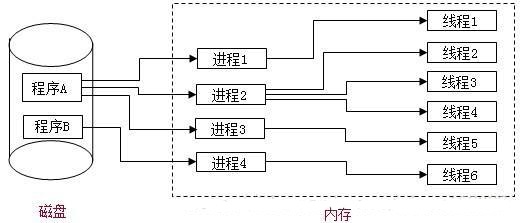(1)在傳統的操作系統中,程序并不能獨立運行,作為資源分配和獨立運行的基本單位都是進程。
在未配置 os 的系統中,程序的執行方式是順序執行,即必須在一個程序執行完后,才允許另一個程序執行;在多道程序環境下,則允許多個程序并發執行。程序的這兩種執行方式間有著顯著的不同。也正是程序并發執行時的這種特征,才導致了在操作系統中引入進程的概念。
自從在 20 世紀 60 年代人們提出了進程的概念后,在 os 中一直都是以進程作為能擁有資源和獨立運行的基本單位的。直到 20 世紀 80 年代中期,人們又提出了比進程更小的能獨立運行的基本單位——線程(threads),試圖用它來提高系統內程序并發執行的程度,從而可進一步提高系統的吞吐量。特別是在進入 20 世紀 90 年代后,多處理機系統得到迅速發展,線程能比進程更好地提高程序的并行執行程度,充分地發揮多處理機的優越性,因而在近幾年所推出的多處理機 os 中也都引入了線程,以改善 os 的性能。
—–以上摘自《計算機操作系統-湯小丹等編著-3 版》
(2)下圖是來自知乎用戶的解釋:

通過上述的大致了解,基本知道線程和進程是干什么的了,那么我們下邊給進程和線程總結一下概念:
(3)進程(process)是計算機中的程序關于某數據集合上的一次運行活動,是系統進行資源分配和調度的基本單位,是操作系統結構的基礎。在早期面向進程設計的計算機結構中,進程是程序的基本執行實體;在當代面向線程設計的計算機結構中,進程是線程的容器。程序是指令、數據及其組織形式的描述,進程是程序的實體。
(4)線程,有時被稱為輕量級進程(lightweight process,lwp),是程序執行流的最小單元。線程是程序中一個單一的順序控制流程。進程內一個相對獨立的、可調度的執行單元,是系統獨立調度和分派cpu的基本單位指運行中的程序的調度單位。在單個程序中同時運行多個線程完成不同的工作,稱為多線程。
(5)進程和線程的關系:

二、java實現多線程方式
(1)繼承thread,重寫run()方法
|
1
2
3
4
5
6
7
8
9
10
11
12
13
14
|
public class mythread extends thread { @override public void run() { while (true) { system.out.println(this.currentthread().getname()); } } public static void main(string[] args) { mythread thread = new mythread(); thread.start(); //線程啟動的正確方式 }} |
輸出結果:
|
1
2
3
4
|
thread-0thread-0thread-0... |
另外,要明白啟動線程的是start()方法而不是run()方法,如果用run()方法,那么他就是一個普通的方法執行了。
(2)實現runable接口
|
1
2
3
4
5
6
7
8
9
10
11
12
13
|
public class myrunnable implements runnable { @override public void run() { system.out.println("123"); } public static void main(string[] args) { myrunnable myrunnable = new myrunnable(); thread thread = new thread(myrunnable, "t1"); thread.start(); }} |
三、線程安全
線程安全概念:當多個線程訪問某一個類(對象或方法)時,這個類始終能表現出正確的行為,那么這個類(對象或方法)就是線程安全的。
線程安全就是多線程訪問時,采用了加鎖機制,當一個線程訪問該類的某個數據時,進行保護,其他線程不能進行訪問直到該線程讀取完,其他線程才可使用。不會出現數據不一致或者數據污染。 線程不安全就是不提供數據訪問保護,有可能出現多個線程先后更改數據造成所得到的數據是臟數據。這里的加鎖機制常見的如:synchronized
四、synchronized修飾符
(1)synchronized:可以在任意對象及方法上加鎖,而加鎖的這段代碼稱為“互斥區”或“臨界區”。
(2)**不使用**synchronized實例(代碼a):
|
1
2
3
4
5
6
7
8
9
10
11
12
13
14
15
16
17
18
19
20
21
|
public class mythread extends thread { private int count = 5; @override public void run() { count--; system.out.println(this.currentthread().getname() + " count:" + count); } public static void main(string[] args) { mythread mythread = new mythread(); thread thread1 = new thread(mythread, "thread1"); thread thread2 = new thread(mythread, "thread2"); thread thread3 = new thread(mythread, "thread3"); thread thread4 = new thread(mythread, "thread4"); thread thread5 = new thread(mythread, "thread5"); thread1.start(); thread2.start(); thread3.start(); thread4.start(); thread5.start(); }} |
輸出的一種結果如下:
|
1
2
3
4
5
|
thread3 count:2thread4 count:1thread1 count:2thread2 count:3thread5 count:0 |
可以看到,上述的結果是不正確的,這是因為,多個線程同時操作run()方法,對count進行修改,進而造成錯誤。
(3)**使用**synchronized實例(代碼b):
|
1
2
3
4
5
6
7
8
9
10
11
12
13
14
15
16
17
18
19
20
21
22
23
24
|
public class mythread extends thread { private int count = 5; @override public synchronized void run() { count--; system.out.println(this.currentthread().getname() + " count:" + count); } public static void main(string[] args) { mythread mythread = new mythread(); thread thread1 = new thread(mythread, "thread1"); thread thread2 = new thread(mythread, "thread2"); thread thread3 = new thread(mythread, "thread3"); thread thread4 = new thread(mythread, "thread4"); thread thread5 = new thread(mythread, "thread5"); thread1.start(); thread2.start(); thread3.start(); thread4.start(); thread5.start(); }} |
輸出結果:
|
1
2
3
4
5
|
thread1 count:4thread2 count:3thread3 count:2thread5 count:1thread4 count:0 |
可以看出代碼a和代碼b的區別就是在run()方法上加上了synchronized修飾。
說明如下:
當多個線程訪問mythread 的run方法的時候,如果使用了synchronized修飾,那個多線程就會以排隊的方式進行處理(這里排隊是按照cpu分配的先后順序而定的),一個線程想要執行synchronized修飾的方法里的代碼,首先是嘗試獲得鎖,如果拿到鎖,執行synchronized代碼體的內容,如果拿不到鎖的話,這個線程就會不斷的嘗試獲得這把鎖,直到拿到為止,而且多個線程同時去競爭這把鎖,也就是會出現鎖競爭的問題。
五、一個對象有一把鎖!多個線程多個鎖!
何為,一個對象一把鎖,多個線程多個鎖!首先看一下下邊的實例代碼(代碼c):
|
1
2
3
4
5
6
7
8
9
10
11
12
13
14
15
16
17
18
19
20
21
22
23
24
25
26
27
28
29
30
31
32
33
34
35
|
public class multithread { private int num = 200; public synchronized void printnum(string threadname, string tag) { if (tag.equals("a")) { num = num - 100; system.out.println(threadname + " tag a,set num over!"); } else { num = num - 200; system.out.println(threadname + " tag b,set num over!"); } system.out.println(threadname + " tag " + tag + ", num = " + num); } public static void main(string[] args) throws interruptedexception { final multithread multithread1 = new multithread(); final multithread multithread2 = new multithread(); new thread(new runnable() { public void run() { multithread1.printnum("thread1", "a"); } }).start(); thread.sleep(5000); system.out.println("等待5秒,確保thread1已經執行完畢!"); new thread(new runnable() { public void run() { multithread2.printnum("thread2", "b"); } }).start(); }} |
輸出結果:
|
1
2
3
4
5
|
thread1 tag a,set num over!thread1 tag a, num = 100等待5秒,確保thread1已經執行完畢!thread2 tag b,set num over!thread2 tag b, num = 0 |
可以看出,有兩個對象:multithread1和multithread2,如果多個對象使用同一把鎖的話,那么上述執行的結果就應該是:thread2 tag b, num = -100,因此,是每一個對象擁有該對象的鎖的。
關鍵字synchronized取得的鎖都是對象鎖,而不是把一段代碼或方法當做鎖,所以上述實例代碼c中哪個線程先執行synchronized 關鍵字的方法,那個線程就持有該方法所屬對象的鎖,兩個對象,線程獲得的就是兩個不同對象的不同的鎖,他們互補影響的。
那么,我們在正常的場景的時候,肯定是有一種情況的就是,所有的對象會對一個變量count進行操作,那么如何實現哪?很簡單就是加static,我們知道,用static修改的方法或者變量,在該類的所有對象是具有相同的引用的,這樣的話,無論實例化多少對象,調用的都是一個方法,代碼如下(代碼d):
|
1
2
3
4
5
6
7
8
9
10
11
12
13
14
15
16
17
18
19
20
21
22
23
24
25
26
27
28
29
30
31
32
33
34
35
|
public class multithread { private static int num = 200; public static synchronized void printnum(string threadname, string tag) { if (tag.equals("a")) { num = num - 100; system.out.println(threadname + " tag a,set num over!"); } else { num = num - 200; system.out.println(threadname + " tag b,set num over!"); } system.out.println(threadname + " tag " + tag + ", num = " + num); } public static void main(string[] args) throws interruptedexception { final multithread multithread1 = new multithread(); final multithread multithread2 = new multithread(); new thread(new runnable() { public void run() { multithread1.printnum("thread1", "a"); } }).start(); thread.sleep(5000); system.out.println("等待5秒,確保thread1已經執行完畢!"); new thread(new runnable() { public void run() { multithread2.printnum("thread2", "b"); } }).start(); }} |
輸出結果:
|
1
2
3
4
5
|
thread1 tag a,set num over!thread1 tag a, num = 100等待5秒,確保thread1已經執行完畢!thread2 tag b,set num over!thread2 tag b, num = -100 |
可以看出,對變量和方法都加上了static修飾,就可以實現我們所需要的場景,同時也說明了,對于非靜態static修飾的方法或變量,是一個對象一把鎖的。
六、對象鎖的同步和異步
(1)同步:synchronized
同步的概念就是共享,我們要知道“共享”這兩個字,如果不是共享的資源,就沒有必要進行同步,也就是沒有必要進行加鎖;
同步的目的就是為了線程的安全,其實對于線程的安全,需要滿足兩個最基本的特性:原子性和可見性;
(2)異步:asynchronized
異步的概念就是獨立,相互之間不受到任何制約,兩者之間沒有任何關系。
(3)示例代碼:
|
1
2
3
4
5
6
7
8
9
10
11
12
13
14
15
16
17
18
19
20
21
22
23
24
25
|
public class myobject { public void method() { system.out.println(thread.currentthread().getname()); } public static void main(string[] args) { final myobject myobject = new myobject(); thread t1 = new thread(new runnable() { public void run() { myobject.method(); } }, "t1"); thread t2 = new thread(new runnable() { public void run() { myobject.method(); } }, "t2"); t1.start(); t2.start(); }} |
上述代碼中method()就是異步的方法。
總結
以上就是本文關于java多線程之線程,進程和synchronized概念初解的全部內容,希望對大家有所幫助。如有不足之處,歡迎留言指出,小編會及時回復大家的。
原文鏈接:http://blog.csdn.net/xlgen157387/article/details/77920497















